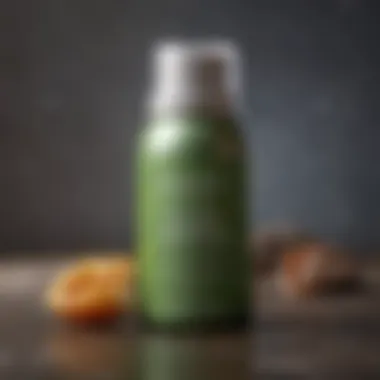Exploring Alternative Cosmetics: A Comprehensive Overview


Intro
As global awareness towards sustainable and ethical consumption grows, the landscape of cosmetics is evolving. Alternative cosmetics represent a shift from conventional products towards formulations that prioritize health, sustainability, and transparency. This article aims to unpack the concept and significance of alternative cosmetics, providing a detailed overview of their formulation, benefits, and their broader implications for health and the environment.
Key Concepts
Definition of the Main Idea
Alternative cosmetics are products designed to provide beauty and personal care solutions while minimizing harm to the environment and human health. Unlike traditional cosmetics, these products are often crafted from natural or organic ingredients and aim to avoid synthetic chemicals and animal testing. They emphasize safety, ethical sourcing, and eco-friendliness.
Overview of Scientific Principles
The formulation of alternative cosmetics relies heavily on the understanding of both chemistry and biology. Ingredients such as plant extracts, essential oils, and naturally derived compounds undergo significant scientific scrutiny. This allows for the development of effective and safe products that serve their intended purpose without compromising consumer health. For example, studies suggest that certain botanicals possess antimicrobial and antioxidant properties that can enhance skin health.
Current Research Trends
Recent Studies and Findings
Recent research has focused on the efficacy and safety of various natural ingredients used in alternative cosmetics. Studies indicate that consumers are increasingly favoring products with labeled natural components. Furthermore, research highlights the potential of ingredients like shea butter and coconut oil, which provide emollient properties beneficial for skin hydration.
Significant Breakthroughs in the Field
Innovations in formulation techniques are driving the alternative cosmetics sector forward. Breakthroughs include the extraction of bioactive compounds using advanced methods that preserve their integrity. This enhances product performance while ensuring sustainability in sourcing practices. The development of microencapsulation technology also allows for the stable delivery of sensitive ingredients in cosmetics.
"The growing demand for alternative cosmetics highlights a paradigm shift in consumer expectations towards sustainability and health."
"The growing demand for alternative cosmetics highlights a paradigm shift in consumer expectations towards sustainability and health."
In summary, exploring alternative cosmetics is essential for understanding how they contribute to a more sustainable and health-conscious approach to beauty and personal care. The ongoing research and commitment to natural ingredients promise to shape the future of the cosmetics industry.
Preamble to Alternative Cosmetics
The topic of alternative cosmetics is increasingly relevant in today’s world. As consumers become more aware of health and environmental issues, they seek products that align with their values. Alternative cosmetics provide options that often emphasize natural ingredients and ethical practices. This section aims to clarify what alternative cosmetics are and how they have evolved over time.
Defining Alternative Cosmetics
Alternative cosmetics can be defined as products that offer an alternative to traditional cosmetics. These items often focus on natural and organic ingredients, avoiding synthetic chemicals commonly found in standard beauty products. Key characteristics include:
- Natural Ingredients: Many alternative cosmetics use plant-based or naturally derived components.
- Ethical Production: Brands typically emphasize sustainability, cruelty-free testing, and eco-friendly practices.
- Health Focus: These cosmetics prioritize safety, often being free from parabens, sulfates, and other harmful substances.
By understanding these definitions, consumers can make informed choices, ensuring their purchases foster their health and ethical beliefs.
The Evolution of Cosmetics
The evolution of cosmetics reflects broader societal changes. Historically, cosmetics were primitive mixtures used for aesthetic enhancement or spiritual purposes. Today, they are driven by technological advancement and changing consumer attitudes. Initially, many cosmetics were composed of natural materials, but as industrialization progressed, synthetic components became prevalent.
In recent years, there has been a significant shift back towards natural formulations. This change is fueled by a growing awareness of the potential health risks associated with synthetic products. As a result, brands are reformulating their offerings to conform to consumer preferences for safer ingredients and sustainable practices.
The evolution of cosmetics now encompasses not just the products themselves, but also the entire industry approach. The focus on transparency in ingredient sourcing and production methods is vital for today’s consumers.
This shift represents more than a trend; it shows an increasing demand for accountability and health consciousness in the beauty industry.
The Science Behind Alternative Cosmetics
The realm of alternative cosmetics is not just about the products themselves; the science behind them plays a crucial role in understanding their formulation, benefits, and the careful considerations involved in their development. Knowledge of cosmetic science allows consumers to make informed decisions. Chemists and formulators are now focusing on the benefits of natural ingredients while addressing the challenges posed by synthetic substances. Additionally, the interplay between formulation and consumer expectations is fundamental to the success of these products.
Understanding Ingredients


Ingredients are the backbone of alternative cosmetics. For these products, sourcing natural or organic components is often a priority. These ingredients can include botanical extracts, essential oils, and natural waxes. Each ingredient must be carefully chosen for its properties and benefits. For instance, coconut oil is known for its moisturizing properties. On the other hand, aloe vera offers soothing qualities, making it a popular ingredient in skincare products. Understanding the role of each ingredient helps ensure efficacy and safety in the final product.
Natural Versus Synthetic Components
The debate between natural and synthetic components continues to be a central theme in cosmetics. Natural ingredients typically come from plants or minerals, while synthetic components are chemically created. Natural ingredients may be less processed, which appeals to consumers looking for healthier options. However, synthetic ingredients can offer certain benefits, such as enhanced stability and purity, which are sometimes absent in natural ones. Evaluating both types of components is essential. It helps consumers determine what is appropriate for their skin type and needs.
Formulation Challenges
Stability
Stability is a significant concern when formulating alternative cosmetics. A stable product maintains its efficacy and appearance over time. Factors affecting stability include temperature, exposure to light, and interaction with other ingredients. For instance, natural oils may become rancid if not properly stabilized. Therefore, achieving stability is critical to ensure that consumers receive a product that remains effective and safe throughout its shelf life.
Compatibility
Compatibility refers to how well different ingredients work together in a formulation. Ingredients must blend without causing separation or chemical reactions that could lead to increased irritation or reduced efficacy. A common challenge arises when combining oil-based and water-based ingredients. Understanding the compatibility of various components allows formulators to create effective formulations and ensures that products deliver the desired benefits without adverse reactions.
Efficacy
Efficacy is about how well a cosmetic product achieves its intended effects. Each ingredient should provide tangible benefits, such as hydration or anti-aging properties. Conducting thorough testing is necessary to validate the efficacy claims made by manufacturers. Consumers need assurance that a product works as intended before making a purchase. This aspect of formulation helps establish trust and encourages repeat use of a product among consumers.
"Understanding the science behind alternative cosmetics is essential for both formulators and consumers to navigate this expanding market effectively."
"Understanding the science behind alternative cosmetics is essential for both formulators and consumers to navigate this expanding market effectively."
Categories of Alternative Cosmetics
The exploration of categories within alternative cosmetics is vital to understanding their role in the broader context of beauty and personal care. Each category serves distinct needs, reflecting diverse consumer preferences and values. This understanding not only highlights the benefits tied to these categories, but also underscores the ethical considerations that have become essential in today's market. From ingredients to packaging methods, each category has implications for health, environment, and animal welfare, inviting deeper examination.
Organic Cosmetics
Organic cosmetics are formulated using ingredients derived from plants that are grown without the use of synthetic pesticides or fertilizers. This category appeals to consumers who prioritize the purity of their cosmetics. The absence of harmful chemicals is a significant benefit, potentially reducing the risk of skin irritations and allergies. Additionally, organic production methods often promote biodiversity and sustainability.
Within organic cosmetics, there are certifications that add credibility to products. For instance, the USDA Organic seal verifies compliance with strict cultivation standards. However, consumers must navigate a marketplace where some brands may exaggerate organic claims, so it is important to scrutinize labels for authenticity.
Vegan Cosmetics
Vegan cosmetics do not contain any animal-derived ingredients. This category is attractive to those who follow a vegan lifestyle and seek to align their cosmetic choices with their ethical beliefs. Ingredients like beeswax, lanolin, and collagen are often excluded from formulations.
Moreover, vegan cosmetics typically avoid animal testing, appealing to consumers concerned about animal welfare. This shift in consumer demand has pushed many brands to reformulate and adopt cruelty-free practices. However, as with organic products, verification through certification is crucial. Labels marked with specific vegan certifications provide assurance to consumers.
Cruelty-Free Cosmetics
Cruelty-free cosmetics are those not tested on animals at any stage of product development. This category has gained significant traction in recent years as awareness of animal rights has grown. Some brands adopt cruelty-free practices while being careful about their ingredient sources—the challenge is ensuring that products are not just cruelty-free but also ethically produced.
The term "cruelty-free" is not regulated universally, hence consumers should look for brands that actively display recognized certifications from organizations that assess cruelty-free claims rigorously. By choosing cruelty-free cosmetics, consumers can support a more ethical beauty industry.
Eco-Friendly Packaging
The conversation around cosmetics is increasingly extending to the packaging in which products come. Eco-friendly packaging focuses on reducing environmental impact. This can include the use of recycled materials or innovative designs aimed at minimizing waste. Such packaging options not only reduce landfill contributions but also reflect a brand's commitment to environmental sustainability.
Many brands now invest in biodegradable materials or refillable containers as a part of their product lines. This packaging shift resonates with environmentally conscious consumers who favor brands that prioritize sustainability at every stage of the product lifecycle. It's important for consumers to consider packaging as part of their purchasing decisions, reinforcing a holistic approach to eco-friendly beauty.
"Choosing alternative cosmetics extends beyond product efficacy; it transcends into our health values, ethical considerations, and environmental responsibilities."
"Choosing alternative cosmetics extends beyond product efficacy; it transcends into our health values, ethical considerations, and environmental responsibilities."
In summary, the categories of alternative cosmetics represent an intersection of health, ethics, and sustainability. As consumers grow more informed and conscientious, they increasingly seek products that align with their values. The landscape of alternative cosmetics is not merely a trend; it reflects a transformative change in the beauty industry catering to the desires and needs of modern consumers.


Consumer Trends and Preferences
Consumer trends significantly shape the alternative cosmetics market. As individuals become more health-conscious and environmentally aware, their preferences are influencing the development and marketing strategies of various products. Understanding these trends enables businesses to align their offerings with consumer demands, which can lead to greater market success and brand loyalty. This section delves into three key areas of interest: market demand for alternative products, shifting attitudes towards ingredients, and the rise of transparency in cosmetic labeling.
Market Demand for Alternative Products
The demand for alternative cosmetic products has surged in recent years. Consumers are increasingly looking for makeup and skincare options that align with their values. This change can be attributed to several factors:
- Health Awareness: Many consumers are now more informed about the effects synthetic ingredients can have on their skin and overall health. As a result, products marketed as organic or free from harmful chemicals are gaining traction.
- Ethical Consumption: The rise of social media has facilitated awareness around ethical practices in the beauty industry. Brands that promote cruelty-free practices or sustainable sourcing attract a dedicated customer base.
- Variety and Innovation: The increased competition has also led companies to innovate, offering a wider range of products that cater to various skin types and personal preferences.
These elements contribute to a robust market for alternative cosmetic items, with increasing sales figures that indicate a permanent shift in consumer behavior.
Shifting Attitudes Towards Ingredients
There has been a noticeable shift in how consumers perceive the ingredients in cosmetic products. Traditionally, consumers might have prioritized brands based on marketing claims about effectiveness or price. Now, more consumers actively scrutinize ingredient lists before purchase. Key shifts include:
- Natural and Biodegradable Ingredients: A growing segment of the market prefers products that use natural materials. This rise is motivated by consumer sentiment concerning not just personal health, but also environmental impact.
- Avoidance of Harsh Chemicals: Many customers express a preference for formulations without parabens, sulfates, and phthalates, viewing them as potentially harmful.
- Desire for Knowledge: Consumers are demanding detailed information about what goes into their cosmetics, driving brands to innovate and reformulate products to meet these evolving expectations.
The Rise of Transparency in Cosmetic Labeling
Transparency in cosmetic labeling is another crucial trend that reflects changing consumer expectations. More than ever, shoppers want to know exactly what is inside the products they use. This rise in demand for transparency has several implications:
- Informed Choices: Brands are now expected to clearly communicate their ingredient sources, sustainability efforts, and production practices. This shift empowers consumers to make informed choices aligned with their values.
- Building Trust: Brands that commit to transparency often enjoy greater customer loyalty. Clear labeling fosters a sense of trust between companies and consumers, with many preferring brands that provide open and honest information.
- Influencing Regulations: As consumers push for more transparency, regulatory bodies are also adapting. They may enforce stricter guidelines on labeling practices, ensuring that consumers receive accurate information.
"The future of the cosmetic industry lies in transparency and sustainable practices, pivotal factors that influence today's discerning shopper.
"The future of the cosmetic industry lies in transparency and sustainable practices, pivotal factors that influence today's discerning shopper.
Health Implications of Alternative Cosmetics
Understanding the health implications of alternative cosmetics is crucial in the context of the growing popularity of these products. With increasing awareness about health and environmental issues, consumers are becoming more discerning about what they apply to their skin. Alternative cosmetics often claim to be safer, cleaner, and more effective than conventional options, but it is important to examine these claims critically. The implications of using these products extend beyond individual health, reflecting broader societal trends towards wellness and sustainability.
Skin Health Considerations
The relationship between cosmetics and skin health is complex. Alternative cosmetics often emphasize their use of natural ingredients, which are perceived as more beneficial for skin than synthetic counterparts. Commonly used natural components include oils from jojoba, almond, and various plant extracts. These ingredients may offer nourishing properties, but not all natural substances are benign. Some individuals might experience adverse reactions to certain botanical extracts, which can lead to irritation and other skin issues.
Furthermore, many alternative products are free from harmful additives like parabens and sulfates, which are often linked to skin problems. While this is a positive aspect, one must also consider that a product’s safety and effectiveness depend on the overall formulation. For instance, even natural products can cause acne if they are too heavy or clog pores. It is therefore crucial for consumers to do thorough research and patch test new products before regular use.
Allergies and Sensitivities
Allergies and sensitivities are significant concerns when it comes to cosmetics. People with sensitive skin or specific allergies may react to common cosmetic ingredients, regardless of whether the products are marketed as alternative. Natural cosmetics may contain allergens that are not present in conventional products, such as essential oils or specific plant derivatives. These reactions can range from mild irritation to severe allergic responses, which necessitates a cautious approach to selecting products.
Consumers should carefully read ingredient labels and be aware of their own sensitivities. Educating themselves on common allergens in both natural and synthetic products can help mitigate potential risks. As a strategy, opting for hypoallergenic products or those specifically formulated for sensitive skin can be beneficial. This step not only enhances personal safety but also promotes an informed approach towards beauty and skincare.
Sustainability and Environmental Impact
Sustainability and environmental impact are critical considerations in the realm of alternative cosmetics. As consumer awareness heightens regarding both health and ecological issues, industry players must navigate the fine line between profitability and responsibility. The shift towards sustainability is not merely a trend; it indicates a necessary adjustment to how cosmetics are produced and consumed. This section explores significant aspects, including resource management in production and the impact on biodiversity.
Resource Management in Production
Effective resource management is essential for creating sustainable cosmetic products. This involves not only the sourcing of raw materials but also the methods utilized during production. Companies are beginning to shift towards responsible sourcing, which can mitigate adverse environmental effects. For instance:
- Renewable Ingredients: Utilization of renewable resources ensures that cosmetic ingredients do not deplete non-renewable reserves, supporting ecological balance.
- Supply Chain Transparency: Individuals now expect brands to be transparent about their sourcing methods. Understanding where and how ingredients are sourced holds companies accountable.
- Water Usage: The cosmetics industry can be notoriously water-intensive. Adopting strategies that reduce water consumption during production is a method many brands are now employing. This can also lead to operational cost savings.
Resource management does not just stop at sourcing. It extends to:
- Waste reduction strategies that minimize excess during production.
- Recycling initiatives to reuse materials whenever possible.
- Collaboration with stakeholders to ensure sustainability standards are met throughout the entire supply chain.


Impact on Biodiversity
The cosmetic industry significantly influences biodiversity, from ingredient sourcing to production practices. Choosing ingredients that harm ecosystems can lead to irreversible consequences. Notable factors include:
- Overharvesting: Ingredients sourced from natural habitats may lead to endangered species. For instance, certain plant extracts, if over-harvested, can disrupt local ecosystems.
- Habitat Destruction: The expansion of agricultural lands for cosmetic ingredients can lead to deforestation, particularly in biodiverse regions like the Amazon rainforest.
- Chemical Pollution: Waste generated during cosmetic production can pollute waterways, affecting both aquatic life and human communities.
Brands are now striving to adopt practices that aid in biodiversity preservation. Initiatives may include:
- Supporting fair trade and local suppliers, which help to maintain regional ecosystems.
- Engaging in habitat restoration projects to counteract the effects of ingredient sourcing.
- Conducting environmental impact assessments to measure and mitigate the effects of their operations.
"Sustainable practices in cosmetics not only benefit the planet but also resonate with consumers who prioritize ethical choices."
"Sustainable practices in cosmetics not only benefit the planet but also resonate with consumers who prioritize ethical choices."
Regulatory Considerations
The landscape of alternative cosmetics is not only shaped by consumer preferences but also significantly influenced by regulatory frameworks. Regulations play a pivotal role in ensuring public safety, fostering innovation, and maintaining integrity in the cosmetic industry. For consumers, understanding these regulations is necessary for making informed choices regarding the products they use on their skin.
Regulatory frameworks differ across regions but share common goals of consumer protection and product efficacy. It is imperative for manufacturers to comply with these regulations to ensure that their products are safe and meet quality standards. The absence of strict regulations may lead to harmful products in the market, jeopardizing consumer health. Therefore, reputable brands prioritize compliance as part of their commitment to ethical practices.
Understanding Cosmetic Regulations
Understanding cosmetic regulations is crucial in the analysis of alternative cosmetics. In many regions, the definition of what constitutes a cosmetic product varies, determining the regulatory scrutiny it will face. For example, in the European Union, cosmetics are subjected to detailed guidelines outlined under the Cosmetics Regulation (EC) No 1223/2009. This regulation mandates that all cosmetics must be safe for human use and that ingredients must be tested thoroughly.
In contrast, the U.S. Food and Drug Administration (FDA) has a more limited scope of authority over cosmetics. While it has the power to take action against unsafe products, it does not pre-approve cosmetics or their ingredients before they are marketed. This disparity means that consumers in the U.S. need to be more vigilant regarding product safety, as testing and approvals are left primarily in the hands of manufacturers.
"Regulatory frameworks are not just bureaucratic hurdles; they ensure that the products applied to our skin meet safety and quality standards."
"Regulatory frameworks are not just bureaucratic hurdles; they ensure that the products applied to our skin meet safety and quality standards."
Safety Standards and Testing
Safety standards and testing are foundational components within regulatory considerations. Manufacturers of alternative cosmetics must adhere to rigorous testing protocols to ensure their products do not pose a risk to consumers. This involves a range of assessments including dermatological tests, stability tests, and clinical trials.
Each ingredient used in the formulation undergoes a risk assessment to evaluate its safety profile. Some of the common safety standards include:
- Toxicological Assessment: Examining the potential health effects of ingredients.
- Microbiological Testing: Ensuring that products are free from harmful microbes.
- Stability Testing: Assessing how a product changes over time under various conditions.
- Ethical Testing Standards: For alternative cosmetics, particularly vegan and cruelty-free products, adherence to ethical testing methods is vital.
The combination of these tests helps to foster trust among consumers about the safety of the products they choose. When brands meet or exceed safety standards, they reinforce their commitment to consumer health and environmental responsibility. As the market for alternative cosmetics continues to grow, the importance of adhering to established safety regulations will only increase.
Future of Alternative Cosmetics
The future of alternative cosmetics is pivotal in shaping the cosmetic industry landscape. As consumers gravitate towards eco-conscious choices, the demand for innovative and sustainable products is increasing. There is a noticeable shift in consumer preferences, with more people seeking cosmetics that align with their values regarding health, environment, and ethics. This section explores the significant aspects of this trend—particularly focusing on innovation in formulation and the role of technology in cosmetic development.
Innovation in Formulation
Innovation in formulation remains a cornerstone for the future of alternative cosmetics. The evolution of cosmetic formulations goes beyond mere aesthetic enhancement. It involves a deep understanding of how ingredients react with skin, safety implications, and environmental sustainability. New ingredients sourced from nature, like plant-based extracts, are gaining popularity for their conditioned efficacy and minimal environmental impact.
Key factors driving innovation include:
- Consumer demand for transparency: Customers prefer products with clear, understandable labels that explain ingredient choices.
- Focus on multifunctionality: There's a rise in formulations that combine several benefits. Products now target multiple skin concerns simultaneously, such as hydration, anti-aging, and protection against pollutants.
- Emphasis on clean beauty: A shift away from harmful chemicals drives brands to innovate by creating products free from parabens, sulfates, and synthetic fragrances. This clean beauty movement encourages brands to seek safer alternatives while maintaining efficacy.
The Role of Technology in Cosmetic Development
Technology plays an integral role in the advancement of alternative cosmetics. Innovations range from research in ingredient sourcing to advancements in production methods. This technology not only enhances the quality of products but also improves their safety and sustainability.
Some notable technological advancements include:
- Biotechnology: It is transforming how ingredients are developed. By using fermentation processes, companies can create sustainable ingredients that mirror those sourced from nature but with less environmental impact.
- Artificial Intelligence and Machine Learning: Brands are harnessing AI for product development. It enables them to analyze consumer preferences and enhance formulation processes more effectively.
- Sustainable Manufacturing Practices: Development of eco-friendly manufacturing processes reduces waste and energy consumption, addressing environmental concerns associated with traditional cosmetics production.
"The future belongs to those who prepare for it today." — Malcolm X.
"The future belongs to those who prepare for it today." — Malcolm X.







